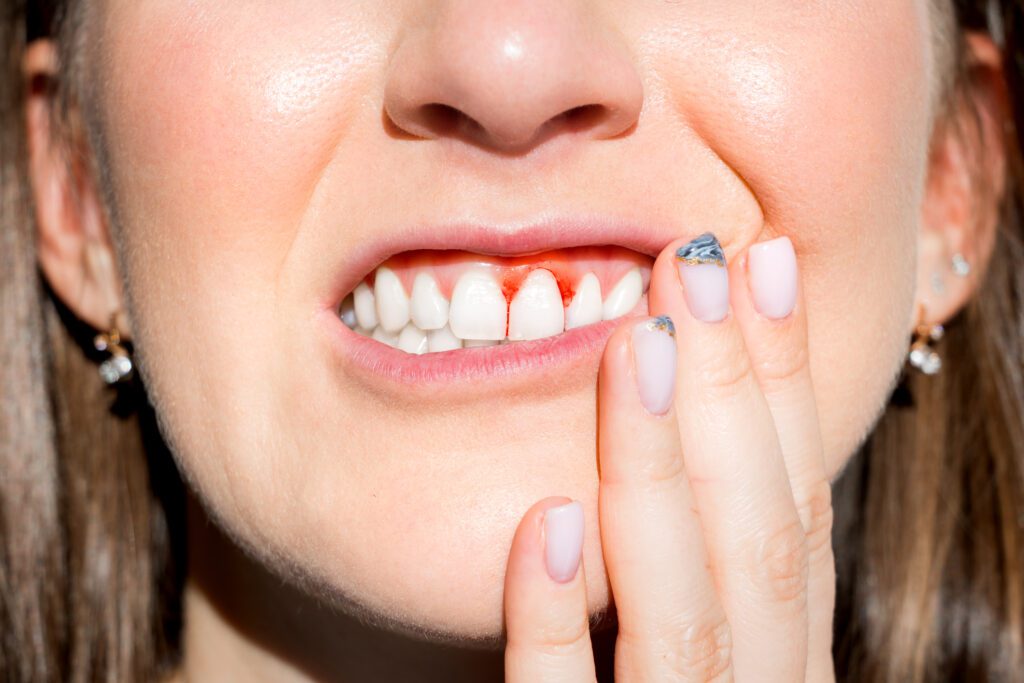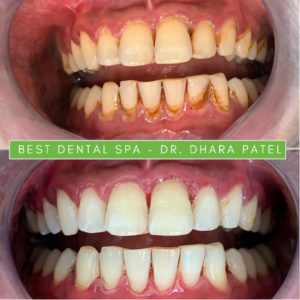One of the major causes of tooth loss in adults is gum disease. Also known as periodontal disease, gum disease is caused by the infection and destruction of the gum tissue. The gums are the soft tissues surrounding, supporting, and protecting teeth. Gums also help to protect us from harmful bacteria in the mouth, serving as a barrier for the bloodstream. At Best Dental Spa, we provide gum disease treatment in Hoffman Estates, IL.
Gum disease can lead to other major health problems, so we must treat teeth and gums properly before symptoms persist. As gum infection progresses, pockets can form between teeth, loosening them or causing them to fall out. Gum disease is the leading cause of tooth loss in adults and should be treated as soon as possible. Treating gum disease will restore your gum health and

Common Signs of Gum Disease
Know the warning signs of gum disease before it takes hold:
- Bleeding gums after brushing and flossing
- Swollen or red gums
- Receding gums
- Deep pockets forming between teeth
- Loose teeth
- Shifting teeth
- Gum and teeth separation
- Halitosis, or persistent bad breath
If you notice these symptoms, we can help with effective restorative dentistry. Gum disease is not just a problem for your gums and teeth.
If left untreated, inflammation of the gums can affect the heart. Gum disease exacerbates heart problems, including strokes and heart attacks. We recommend contacting our office if you have heart problems and notice changes in your gum health. Early preventive treatment can reduce your risk of heart complications.
The Stages of Gum Disease
There are multiple stages of gum disease. In the earlier stages, the symptoms aren’t noticeable. This is why gum disease is so prevalent in adults. If you notice that your gums are frequently bleeding multiple times a week, it’s time to check in with your dentist.
Gingivitis
Gum inflammation, or gingivitis, is the earliest stage of gum disease and the only reversible stage. It occurs when plaque builds up on the teeth along the gumline, irritating the gum tissue. Most of these symptoms are painless, so monitoring bleeding gums is essential. Diligent brushing, flossing, dentist visits, and possibly antibacterial mouth rinses can reverse this stage of gum disease.
Mild Periodontal Disease
At this stage, gum disease is no longer reversible. Pockets filled with bacteria and debris form between your gums and teeth, and the gums start to pull away from the bone. The more aggressive bacteria begin to contribute to bone loss.
Scaling and root planing are required at this stage to manage the infection. We clean out those gum pockets and smooth down the tooth roots so they can reattach to the gums.
Moderate Periodontal Disease
At this stage, the bacteria attack the ligaments supporting the gums. Inflammation can enter the bloodstream, increasing your risk of problems in different body parts, including the heart. You will notice chronic bad breath and may develop an abscess or pus in your gums. We can manage the third stage with non-surgical treatments like antibiotics and regular scaling and root planing.
Severe Periodontal Disease
In the final stage, the infection has completely evolved into bacteria that cause disease. Your gum pockets are extremely deep, and your teeth may become loose or even fall out.
Your gums become swollen and filled with pus, causing them to ooze and give you severe halitosis. Surgery or laser gum therapy are the only options to manage at this stage.
Periodontal Therapy: Gum Disease Treatment in Hoffman Estates, IL
You can conservatively treat and manage early gum disease or gingivitis through antibacterial rinses and lifestyle adjustments. Routine dental care is essential to maintain your gum health. You likely have gum inflammation if you notice your gums bleed when you brush and floss. Continuing to brush and floss can stop your symptoms.
However, if you notice continual gum problems, schedule a dental visit. Our dental hygienists can remove calculus from your teeth and gums that you can’t remove with brushing alone.
If we discover you have gum disease, we will recommend the proper treatment to reverse your symptoms. Dr. Patel can spot the early signs of gum disease and offer personalized advice for avoiding gum health problems.
Antibiotics can help remove bacteria that cause infection, but they may not be enough when an infection is severe. We help manage gum disease through these standard surgical and non-surgical methods:
- Scaling and Root Planing: These treatments help clean the gums and treat gum inflammation. Scaling is a deep cleaning treatment that goes beneath the gum line to remove plaque and tartar. Root planing smooths out tooth roots to help the gums reattach to teeth.
- Gum graft surgery: During this surgery, we take healthy gum tissue from another area in the mouth and use it to cover your tooth roots. When the gums recede, it can loosen permanent teeth. Gum grafting prevents tooth loss in the later stages of gum disease.
- Flap surgery: During flap surgery, we lift the gums and clean plaque and tartar from beneath the gum line. This treatment can address deep gum pockets. We often recommend flap surgery in the most advanced stages of gum disease.
Real Patients, Real Results

Gum Disease FAQs
Learn more about gum disease treatment in Hoffman Estates, IL
Does Laser Periodontal Therapy hurt?
One of the biggest advantages of laser therapy is its pain-free procedure. In some cases, anesthesia keeps patients comfortable throughout laser procedures. However, patients rarely experience pain during laser procedures.
How long does periodontal treatment take?
Gum treatment typically takes around 2 hours from start to finish. We typically sedate patients for periodontal therapy. In some cases, patients may only use an anesthetic.
Will I lose my teeth if I have gum disease?
Periodontal disease can lead to tooth loss over time. Gum diseases can progress and damage soft tissue, directly affecting the root that connects to your teeth. This may lead to tooth loss or the need for tooth removal.
Schedule a Dental Exam and Periodontal Consultation
Have you noticed any of the common signs of gum disease? Call Best Dental Spa for treatment at 847.660.6603, or request a dentist office visit with Dr. Patel online.
